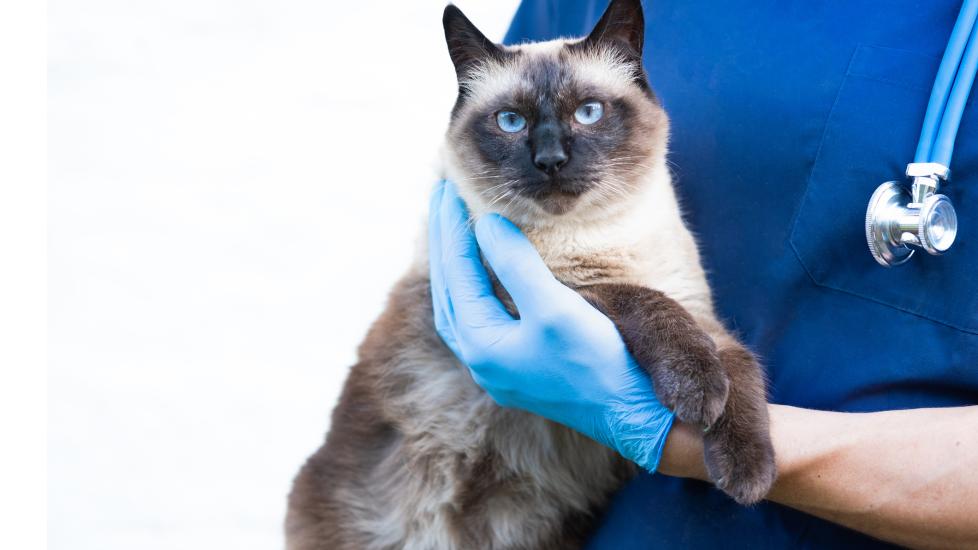Enlarged Heart in Cats
YanaVasileva/iStock / Getty Images Plus via Getty Images
What Is an Enlarged Heart in Cats?
An enlarged heart in cats is typically caused by dilated cardiomyopathy (DCM). Although DCM occurs infrequently in cats, it causes a devastating outcome in most cases.
DCM causes the muscular part of the heart (myocardium) to become weak and unable to pump blood efficiently to the rest of the body. Blood builds up in the heart, causing the walls of the heart to become thinner and the heart chambers to become enlarged. Over time, congestive heart failure develops.
DCM most commonly affects the left side of the heart, causing fluid to build up in the lungs. As a result, affected cats typically show signs of respiratory distress, such as panting, increased respiratory rate, and coughing. In rare cases, right-sided heart enlargement may occur, which can lead to ascites, which is fluid in the abdomen.
DCM can cause significant discomfort for cats, especially as the disease worsens.
Cats in respiratory distress are considered to be experiencing a medical emergency and should be seen by a veterinarian immediately for treatment.
Symptoms of an Enlarged Heart in Cats
Symptoms of an enlarged heart in cats include:
-
Increased respiratory rate
-
Difficulty breathing
-
Coughing
-
Weak pulse
-
Decreased body temperature (hypothermia)
-
Pale gums
-
Distended abdomen
Causes of an Enlarged Heart in Cats
Historically, an enlarged heart in cats was caused by a taurine deficiency. Taurine is an amino acid that is necessary for proper heart function in cats.
Today, commercial pet food companies supplement their diets with taurine. Because of this, taurine-responsive DCM is rare, except in cats fed homemade diets without the appropriate amount of taurine.
Rare cases of DCM have occurred in cats fed grain-free diets. Research to determine whether there is a correlation between the two is ongoing.
Most current cases of DCM in cats are idiopathic, which means they result from an unknown cause.
DCM is most common in middle-aged and older cats. The condition can affect all breeds, but Burmese, Abyssinian, and Siamese cats are diagnosed more frequently, most likely due to genetics. Male and female cats are equally likely to be affected.
How Veterinarians Diagnose an Enlarged Heart in Cats
Diagnosis of an enlarged heart in cats begins with a though physical exam. Your veterinarian will listen carefully to your cat’s heart and lungs with a stethoscope to identify a heart murmur, abnormal heart rhythm, or unusual lung sounds. Heart and respiratory rates will be noted.
Additional diagnostic tests that can be done include:
-
Taurine levels—In cats fed a homemade or limited-ingredient diet, measuring taurine levels in the blood can help determine whether this nutritional deficiency is present.
-
Electrocardiogram (EKG)—Electrodes are placed on a cat’s chest to track their heart rate and rhythm, which can be abnormal in cats with an enlarged heart.
-
Chest X-rays—Images of your cat’s chest may be taken to identify heart enlargement or fluid in the lungs.
-
Echocardiogram—An ultrasound of the heart allows a veterinarian to visualize the heart in real time as it pumps. An echocardiogram is the preferred test to diagnose DCM and is performed by a veterinary cardiologist.
Treatment of an Enlarged Heart in Cats
An enlarged heart in cats is not curable, and treatment focuses on managing the symptoms of heart failure. When cats are first diagnosed with this condition, they often need to be stabilized, which may involve the following treatments:
-
Oxygen therapy—Supplemental oxygen can be administered to help cats breathe more easily.
-
Thoracentesis—If your veterinarian suspects that fluid has built up in the chest, they may use a needle to drain the fluid.
-
Diuretics—These medications can be given orally or by injection to remove excess fluid from the lungs and abdomen that has accumulated due to heart failure. Furosemide is the most common diuretic used for this purpose.
-
Pimobendan—This medication is given orally to improve the heart’s pumping ability, so more blood is sent to the rest of the body.
-
ACE inhibitors—These medications decrease blood pressure and help the heart pump blood more effectively. Examples include enalapril and benazepril.
-
Taurine—Although heart enlargement due to taurine deficiency is rare, some cats may benefit from taurine supplementation.
-
Anticoagulants—Cats in heart failure have an increased risk for developing blood clots. Giving an anti-clotting mediation, such as clopidogrel, can reduce this risk.
Recovery and Management of an Enlarged Heart in Cats
An enlarged heart in cats is a terminal disease if it’s caused by a condition other than taurine deficiency.
On average, cats diagnosed with non-taurine-responsive DCM live only 11 days after diagnosis. This is likely because DCM is a progressive disease and most affected cats are already in heart failure by the time they are seen by a veterinarian.
Cats with an enlarged heart due to a taurine deficiency have a similarly poor prognosis during the initial treatment period. However, once taurine supplementation raises the concentration in the blood, most cats recover fully. It can take several months for a cat’s heart to return to normal in these cases.
Prevention of an Enlarged Heart in Cats
Because the cause of an enlarged heart in cats is typically unknown, it is difficult to prevent most cases.
However, since taurine deficiency has been shown to contribute to this condition in the past, pet parents should feed their cats a commercial cat food rather than a homemade diet.
